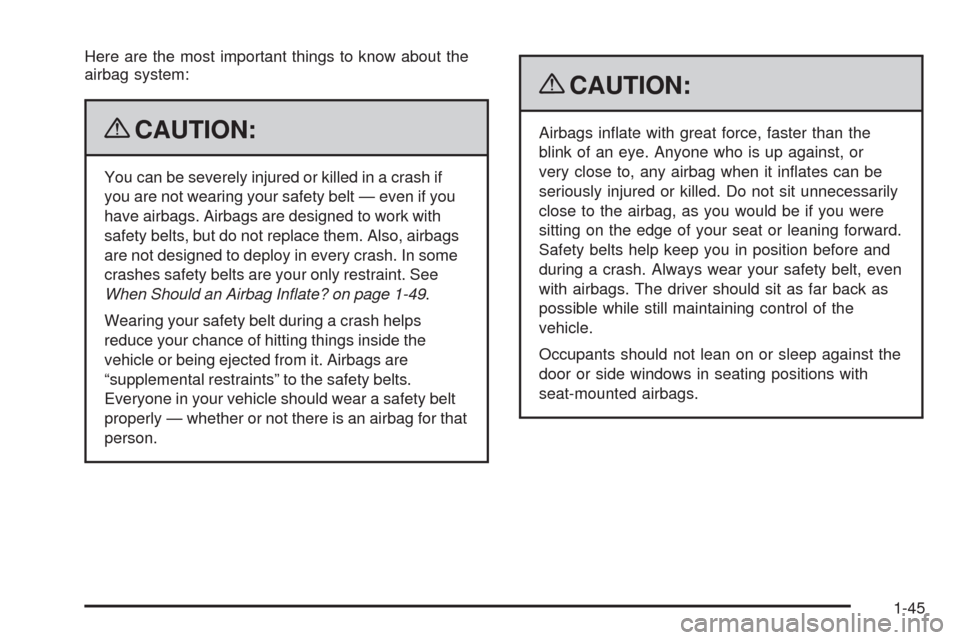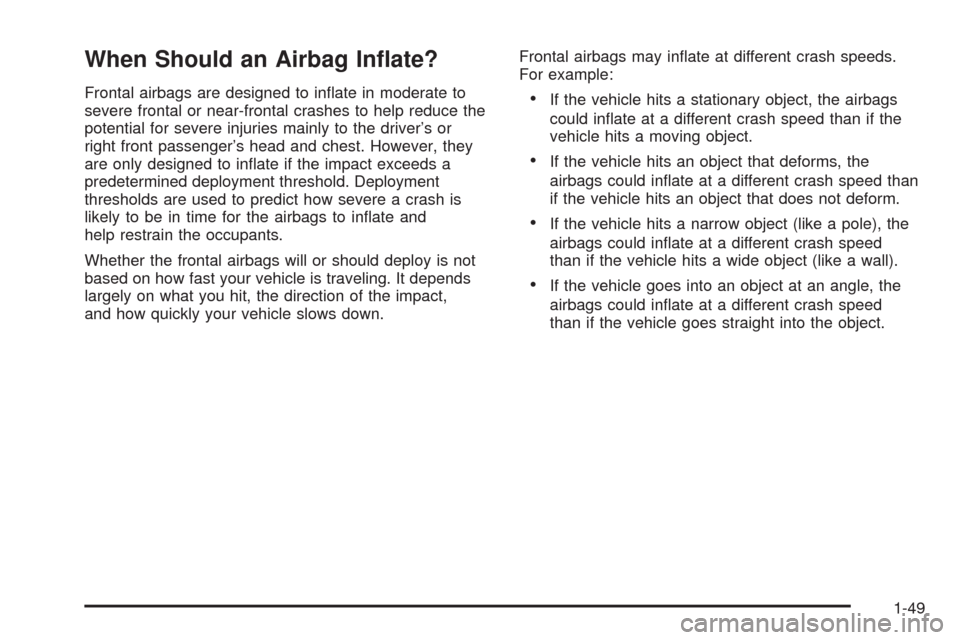Page 45 of 434

CAUTION: (Continued)
Even if the passenger sensing system has turned
off the right front passenger frontal airbag, no
system is fail-safe. No one can guarantee that an
airbag will not deploy under some unusual
circumstance, even though it is turned off.
Secure rear-facing child restraints in a rear
seat, even if the airbag is off. If you secure a
forward-facing child restraint in the right front seat,
always move the front passenger seat as far back
as it will go. It is better to secure the child restraint
in a rear seat.
SeePassenger Sensing System on page 1-53for
additional information.Rear-facing child restraints should not be installed in the
vehicle, even if the airbag(s) are off.
If the child restraint has the LATCH system, seeLower
Anchors and Tethers for Children (LATCH) (Coupe and
Convertible Models Only) on page 1-36orLower Anchors
and Tethers for Children (LATCH) (Z06 and ZR1 Models
Only) on page 1-36for how and where to install the child
restraint using LATCH. If a child restraint is secured
using a safety belt and it uses a top tether, seeLower
Anchors and Tethers for Children (LATCH) (Coupe and
Convertible Models Only) on page 1-36orLower Anchors
and Tethers for Children (LATCH) (Z06 and ZR1 Models
Only) on page 1-36for top tether anchor locations.
Do not secure a child seat in a position without a top
tether anchor if a national or local law requires that
the top tether be anchored, or if the instructions
that come with the child restraint say that the top strap
must be anchored.
1-41
Page 46 of 434

In Canada, the law requires that forward-facing child
restraints have a top tether, and that the tether be
attached.
You will be using the lap-shoulder belt to secure the
child restraint in this position. Follow the instructions that
came with the child restraint.
1. Move the seat as far back as it will go before
securing the forward-facing child restraint.
When the passenger sensing system has turned off
the right front passenger frontal airbag and
seat-mounted side impact airbag (if equipped), the
off indicator on the passenger airbag status
indicator should light and stay lit when you start the
vehicle. SeePassenger Airbag Status Indicator
on page 3-36.
2. Put the child restraint on the seat.
3. Pick up the latch plate, and run the lap and shoulder
portions of the vehicle’s safety belt through or
around the restraint. The child restraint instructions
will show you how.4. Push the latch plate into the buckle until it clicks.
Position the release button on the buckle so that
the safety belt could be quickly unbuckled if
necessary.
1-42
Page 48 of 434

7. If the child restraint has a top tether, follow the
child restraint manufacturer’s instructions regarding
the use of the top tether. SeeLower Anchors
and Tethers for Children (LATCH) (Coupe and
Convertible Models Only) on page 1-36orLower
Anchors and Tethers for Children (LATCH)
(Z06 and ZR1 Models Only) on page 1-36for
more information.
8. Push and pull the child restraint in different
directions to be sure it is secure.
If the airbag or airbags are off, the off indicator in the
passenger airbag status indicator will come on and stay
on when the vehicle is started.
If a child restraint has been installed and the on
indicator is lit, see “If the On Indicator is Lit for a
Child Restraint ” underPassenger Sensing System
on page 1-53for more information.
To remove the child restraint, unbuckle the vehicle
safety belt and let it return to the stowed position.Airbag System
The vehicle has the following airbags:
A frontal airbag for the driver.
A frontal airbag for the right front passenger.
The vehicle may have the following airbags:
A seat-mounted side impact airbag for the driver.
A seat-mounted side impact airbag for the right front
passenger.
All of the airbags in the vehicle will have the word
AIRBAG embossed in the trim or on an attached label
near the deployment opening.
For frontal airbags, the word AIRBAG will appear on the
middle part of the steering wheel for the driver and
on the instrument panel for the right front passenger.
With seat-mounted side impact airbags, the word
AIRBAG will appear on the side of the seatback closest
to the door.
Airbags are designed to supplement the protection
provided by safety belts. Even though today’s airbags
are also designed to help reduce the risk of injury
from the force of an in�ating bag, all airbags must in�ate
very quickly to do their job.
1-44
Page 49 of 434

Here are the most important things to know about the
airbag system:
{CAUTION:
You can be severely injured or killed in a crash if
you are not wearing your safety belt — even if you
have airbags. Airbags are designed to work with
safety belts, but do not replace them. Also, airbags
are not designed to deploy in every crash. In some
crashes safety belts are your only restraint. See
When Should an Airbag Inflate? on page 1-49.
Wearing your safety belt during a crash helps
reduce your chance of hitting things inside the
vehicle or being ejected from it. Airbags are
“supplemental restraints” to the safety belts.
Everyone in your vehicle should wear a safety belt
properly — whether or not there is an airbag for that
person.
{CAUTION:
Airbags in�ate with great force, faster than the
blink of an eye. Anyone who is up against, or
very close to, any airbag when it in�ates can be
seriously injured or killed. Do not sit unnecessarily
close to the airbag, as you would be if you were
sitting on the edge of your seat or leaning forward.
Safety belts help keep you in position before and
during a crash. Always wear your safety belt, even
with airbags. The driver should sit as far back as
possible while still maintaining control of the
vehicle.
Occupants should not lean on or sleep against the
door or side windows in seating positions with
seat-mounted airbags.
1-45
Page 50 of 434
{CAUTION:
Children who are up against, or very close to, any
airbag when it in�ates can be seriously injured or
killed. Airbags plus lap-shoulder belts offer
protection for adults and older children, but not for
young children and infants. Neither the vehicle’s
safety belt system nor its airbag system is designed
for them. Young children and infants need the
protection that a child restraint system can provide.
Always secure children properly in your vehicle. To
read how, seeOlder Children on page 1-25or
Infants and Young Children on page 1-29.There is an airbag
readiness light on the
instrument panel, which
shows the airbag symbol.
The system checks the airbag electrical system for
malfunctions. The light tells you if there is an electrical
problem. SeeAirbag Readiness Light on page 3-35
for more information.
1-46
Page 51 of 434
Where Are the Airbags?
The driver frontal airbag is in the middle of the steering
wheel.The right front passenger frontal airbag is in the
instrument panel on the passenger’s side.
1-47
Page 52 of 434
If the vehicle has seat-mounted side impact airbags for
the driver and right front passenger, they are in the
side of the seatbacks closest to the door.
{CAUTION:
If something is between an occupant and an airbag,
the airbag might not in�ate properly or it might force
the object into that person causing severe injury or
even death. The path of an in�ating airbag must be
kept clear. Do not put anything between an
occupant and an airbag, and do not attach or put
anything on the steering wheel hub or on or near
any other airbag covering.
Do not use seat accessories that block the in�ation
path of a seat-mounted side impact airbag.
Driver Side shown, Passenger Side similar
1-48
Page 53 of 434

When Should an Airbag In�ate?
Frontal airbags are designed to in�ate in moderate to
severe frontal or near-frontal crashes to help reduce the
potential for severe injuries mainly to the driver’s or
right front passenger’s head and chest. However, they
are only designed to in�ate if the impact exceeds a
predetermined deployment threshold. Deployment
thresholds are used to predict how severe a crash is
likely to be in time for the airbags to in�ate and
help restrain the occupants.
Whether the frontal airbags will or should deploy is not
based on how fast your vehicle is traveling. It depends
largely on what you hit, the direction of the impact,
and how quickly your vehicle slows down.Frontal airbags may in�ate at different crash speeds.
For example:If the vehicle hits a stationary object, the airbags
could in�ate at a different crash speed than if the
vehicle hits a moving object.
If the vehicle hits an object that deforms, the
airbags could in�ate at a different crash speed than
if the vehicle hits an object that does not deform.
If the vehicle hits a narrow object (like a pole), the
airbags could in�ate at a different crash speed
than if the vehicle hits a wide object (like a wall).
If the vehicle goes into an object at an angle, the
airbags could in�ate at a different crash speed
than if the vehicle goes straight into the object.
1-49